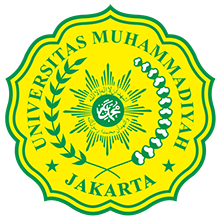Manufacture of Biodegradable Plastics from Cassava Starch (Manihot Escullenta) with Variable Glycerol Plasticizers and Chitosan Reinforcement
Abstract
Biodegradable plastic is an alternative environmentally friendly packaging material because it is made from renewable materials and is scientifically easily degraded by microorganisms and by weather. Renewable material that is abundant in Indonesia is cassava which has high potential as a raw material for making biodegradable plastics. Purpose This study was conducted to determine the process of making biodegradable plastic from cassava starch, knowing the effect of adding glycerol and chitosan to the mechanical properties of biodegradable plastics, and know the characteristics of biodegradable plastics from the best conditions. The process of making biodegradable plastic from cassava starch begins with mixing cassava starch with water and processing until starch dough is formed. Next, glycerol is added to the starch dough and mixed until homogeneous. The final stage is chitosan added to the mixture and stirred until well mixed. The mixture is then heated and molded according to the desired shape. Biodegradable plastics produced from a mixture of cassava starch, glycerol, and chitosan have good mechanical properties and can decompose naturally in the environment for the study variables with concentrations of glycerol 2%,4%,6%,8%,10% and chitosan 1%,3%,5%,7%,9% in a mixture of 100 ml. Mechanical tests such as tensile strength, percent elongation and biodegradation of biodegradable plastics are carried out on product characteristics. The result of this study was to obtain the highest tensile strength in sample 1 of 3.41 Mpa and had an elongation of 68%. While the highest elongation in sample 3 was 130% and tensile strength was 0.26 MPa. The highest biodegradation result in sample 1 was 31.70% and the lowest in sample 5 was 6.55%.
Keywords
Full Text:
PDFReferences
Indriana, S. I. (2015). Pemanfaatan Tepung Kulit Singkong (Manihot Utilissima) Untuk Pembuatan Plastik Ramah Lingkungan (Biodegradable) Dengan Penambahan Gliserol Dari Minyak Jelantah.
Cengristitama., & Ramlan, S. (2022). Pengaruh Penambahan Plasticizer Gliserol dan Kitosan Terhadap Karakteristik Plastik Biodegradable Berbahan Dasar Pati Sukun. (TEDC Vol.16, No.2).
Ismaya, F., Fithriyah, N. H., & Hendrawati, T. Y. (2021). Pembuatan dan Karakterisasi Edible Film dari Nata De Coco dan Gliserol. 13(1). https://doi.org/10.24853/jurtek.13.1.81-88
Apriyansyah, Nugrahani Ratri. A., & Ismiyati. (2022). Preparation and Characterization of Mechanical Properties Improved Bioplastics from Rice Bran with Varying Glycerol Volume.
Maneking, E., Sangian, H., & Tongkukut, S. (2020). Pembuatan dan Karakterisasi Bioplastik Berbahan Dasar Biomassa dengan Plasticizer Gliserol. Jurnal MIPA (Vol. 9, No.1). https://ejournal.unsrat.ac.id/index.php/jmuo
Krisnadi, R., Handarni, Y., Udyani, K., & Kimia, J. T. (2019). Pengaruh Jenis Plasticizer Terhadap Karakteristik Plastik Biodegradable dari Bekatul Padi.
Yustinah., Noviyanti, S., Hasyim, U. H., Syamsudin AB. (2019). Pengaruh Penambahan Kitosan dalam Pembuatan Plastik Biodegradable dari Rumput Laut Gracilaria Sp dengan Pemlastik Sorbitol.
Selpiana., Jeo, F. R., & Yordan, K. (2020). Pembuatan Plastik Biodegradable dari Tepung Nasi Aking.
Marlina, L., Tsania, N., & Achmad, F. (2021). Pengaruh Variasi Penambahan Kitosan dan Gliserol Terhadap Karakteristik Plastik Biodegradable dari Pati Ubi Jalar (Vol. 15, Issue 2).
Elly Agustin, Y., & Samuel Padmawijaya, K. (2016). Sintesis Bioplastik dari Kitosan-Pati Kulit Pisang Kepok dengan Penambahan Zat Aditif.
Nafiah., Asyiah, I., & Fikti, K. (2017). Kajian Etnobotani Tanaman Singkong yang Berpotensi sebagai Obat oleh Masyarakat Kabupaten-Bondosowo. http://jurnal.unej.ac.id/index.php/STF
Aripin, S., Saing, B., & Kustiyah, E. (2017). Studi Pembuatan Bahan Alternatif Plastik Biodegradable dari Pati Ubi Jalar dengan Plasticizer Gliserol dengan Metode Melt Intercalation. Jurnal Teknik Mesin, 6(2), 18.
Dewi, S. R., Chairunisa, N. N., Nugrahani, R. A., Ningsih, T. D., Fithriyah, N. H., & Kosasih, M. (2020). Pembuatan dan Karakterisasi Kelarutan dalam Air dan Biodegradibilitas Bioplastik dari Campuran Dedak Padi-Jagung. Seminar Nasional Penelitian LPPM UMJ Website: http://jurnal.umj.ac.id/index.php/semnaslit E- http://jurnal.umj.ac.id/index.php/semnaslit
Nugraha, L. A., Triastianti, R. D., & Prihandoko, D. (2020). Uji Perbandingan Plastik Biodegradable Pati Singkong dan Pati Kentang terhadap Kekuatan Tarik dan Pemanjangan. Jurnal Rekayasa Lingkungan, 20.
Hartatik, Y., Nuriyah, L., & Iswarin. (2014). Pengaruh Komposisi Kitosan terhadap Sifat Mekanik dan Biodegradable Bioplastik.
Alim, M. D., Karangan, A., Suprihatin., & Nandini, A. (2023). Pemanfaatan Limbah Nasi Aking pada Pembuatan Bioplastik dengan Kitosan dan Plasticizer Gliserol. In Jurnal Teknik Kimia (Vol. 17, Issue 2).
Selpiana., Patricia., & Anggraeni, C. (2016). Pengaruh Penambahan Kitosan dan Gliserol pada Pembuatan Bioplastik dari Ampas Tebu dan Ampas Tahu. In Jurnal Teknik Kimia (Vol.22, No.1).
Hidayat, F., Syaubari., & Salima, R. (2020). Pemanfaatan Pati Tapioka dan Kitosan dalam Pembuatan Plastik Biodegradable dengan Penambahan Gliserol sebagai Plasticizer. Jurnal Litbang Industri, 10(1), 33. https://doi.org/10.24960/jli.v10i1.5970.33-38
Solekah, S., Sasria, N., & Dewanto, H. (2021). Pengaruh Penambahan Gliserol dan Kitosan Kulit Udang terhadap Biodegradasi dan Ketahanan Air Plastik Biodegradable. In Jurnal Ilmu Kimia dan Terapan (Vol. 8, Issue 2).
Nurhidayanti, N., Wardani, I., & Ilyas, N. (2021). Studi Optimasi Komposisi Gliserol dan Kitosan terhadap Karakteristik Sifat Fisik Plastik Biodegrable dari Limbah Nasi Aking dan Tepung Tapioka. In Jurnal Ecotrophic (Vol. 15, No.1, ISSN:2503-3395)
DOI: https://doi.org/10.24853/jasat.7.1.1-6
Refbacks
- There are currently no refbacks.
Copyright of Journal of Applied Sciences and Advanced Technology (JASAT)


![]()
This work is licensed under a Creative Commons Attribution-NonCommercial 4.0 International License















_2.png)


1.png)

2.png)



